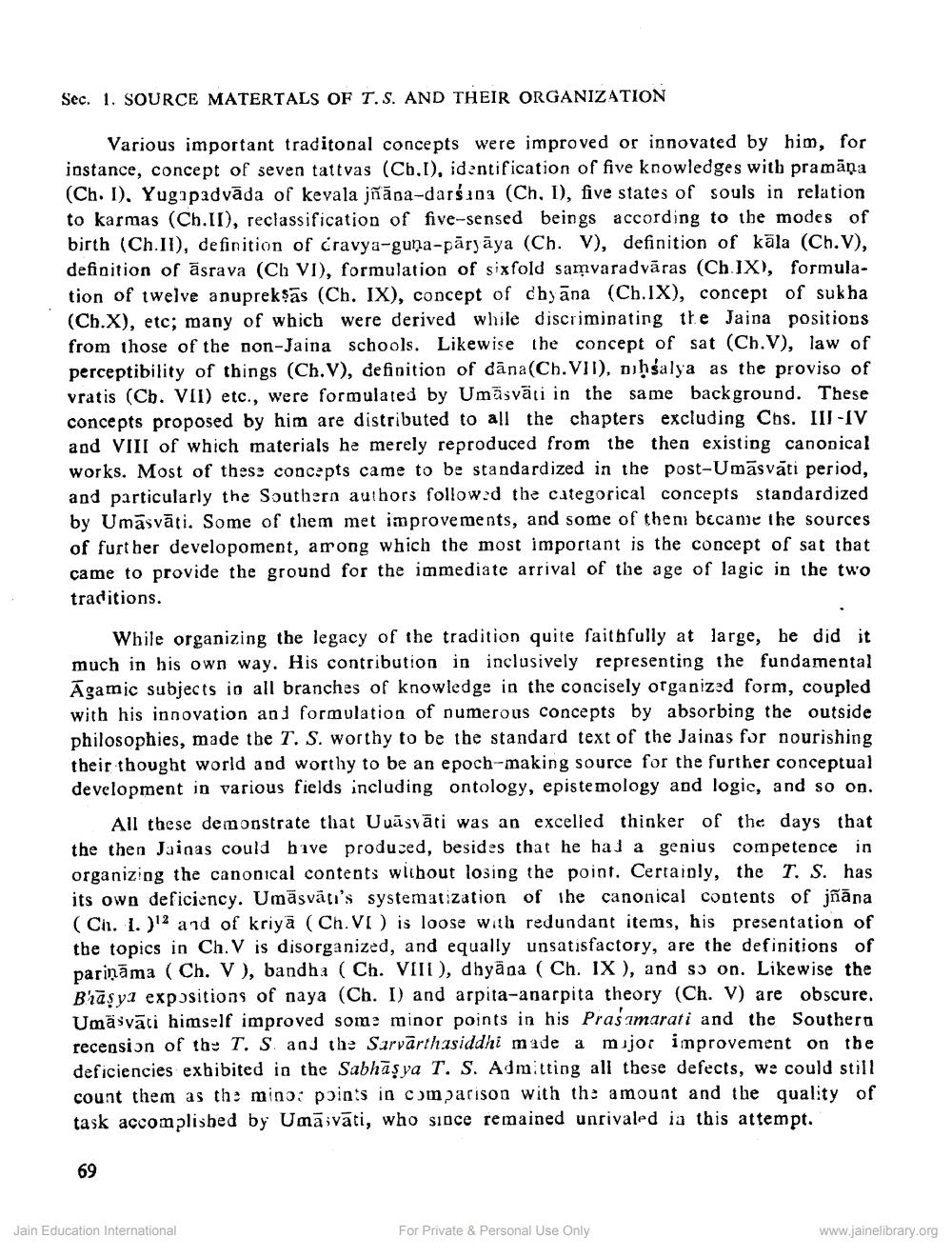________________
Sec. 1. SOURCE MATERTALS OF T.S. AND THEIR ORGANIZATION
Various important traditonal concepts were improved or innovated by him, for instance, concept of seven tattvas (Cb.I), identification of five knowledges with pramāņa (Ch. I), Yugapadvāda of kevala jñāna-darsana (Ch, I), five states of souls in relation to karmas (Ch.II), reclassification of five-sensed beings according to the modes of birth (Ch.11), definition of cravya-guna-pāryāya (Ch. V), definition of käla (Ch.V), definition of āsrava (Ch VI), formulation of sixfold samvaradvāras (Ch.IX), formulation of twelve anupreksās (Ch. IX), concept of chyāna (Ch.IX), concept of sukha (Ch.X), etc; many of which were derived while discriminating the Jaina positions from those of the non-Jaina schools. Likewise the concept of sat (Ch.V), law of perceptibility of things (Ch.V), definition of dāna(Ch.VII), Dihsalya as the proviso of vratis (Ch. VII) etc., were formulated by Umāsvāli in the same background. These concepts proposed by him are distributed to all the chapters excluding Chs. II-IV and VIII of which materials he merely reproduced from the then existing canonical works. Most of these concepts came to be standardized in the post-Umāsvāti period, and particularly the Southern authors followed the categorical concepts standardized by Umāsvāti. Some of them met improvements, and some of them became the sources of further developoment, among which the most important is the concept of sat that came to provide the ground for the immediate arrival of the age of lagic in the two traditions.
While organizing the legacy of the tradition quite faithfully at large, he did it much in his own way. His contribution in inclusively representing the fundamental Āgamic subjects in all branches of knowledge in the concisely organized form, coupled with his innovation and formulation of numerous concepts by absorbing the outside philosophies, made the T. S. worthy to be the standard text of the Jainas for nourishing their thought world and worthy to be an epoch-making source for the further conceptual development in various fields including ontology, epistemology and logic, and so on.
All these demonstrate that Uuāsvāti was an excelled thinker of the days that the then Jainas could have produced, besides that he had a genius competence in organizing the canonical contents without losing the point. Certainly, the T. S. has its own deficiency. Umāsvāti's systematization of the canonical contents of jñāna (Ci. 1. )'2 and of kriyā (Ch.VI) is loose with redundant items, his presentation of the topics in Ch. V is disorganized, and equally unsatisfactory, are the definitions of pariņāma ( Ch. V), bandha (Ch. VIII), dhyāna ( Ch. IX), and so on. Likewise the Biāşya expositions of naya (Ch. I) and arpita-anarpita theory (Ch. V) are obscure. Umāsvāti himself improved some minor points in his Pras imarati and the Southern recension of th: T. S and the Sarvārthasiddhi made a major improvement on the deficiencies exbibited in the Sabhāşya T. S. Admitting all these defects, we could still count them as the mino: points in comparison with the amount and the quality of task accomplished by Umāvāti, who sioce remained unrivaled ia this attempt.
69
Jain Education International
For Private & Personal Use Only
www.jainelibrary.org




